|

Gortyn
Gortyn,
or Gortys as it was called in ancient times, was the most
important Roman town on Crete, but
its origins go back to the end of the Bronze Age. The
date of the foundation of Gortyn is lost in the depths of
time, as is clear from a series of myths that take place in
the vicinity. It is here that Zeus took Europa after
her abduction. Tradition holds that the town owes its
name to the hero, Gortys, who according to some was the son
of Rhadamanthys, the brother of Minos, and to others was the
son of Tegeates. The town was already recognized by Homer as
a walled city and Plato mentions it in his Laws as a
well-governed, powerful and affluent town.
During the Classical period, it was in constant conflict
with Knossos over the hegemony of
Crete, but cultivated peaceful relations with the Achaeans
and the Ptolemaic rulers of Egypt.
In the 3rd century
BCE, Gortyn captured Phaistos and
its port, Matala. During
the period of Roman domination it knew its greatest period
of prosperity since it took the side of the Romans and did
not put up any resistance against them. In exchange,
not only did the Romans not destroy the city as they had
done to the other cities which had resisted, but
they helped Gortyn extend its dominion in 69 BCE by making it the
capital of the Roman province that included not only Crete,
but also much of North Africa.
Gortyn accepted Christianity early and became the seat
of the first Bishop of Crete, the Apostle Titus. In
the early Byzantine period, it flourished and retained its
prestige until 828 CE when it was taken and destroyed by
Arab raiders. From that time on, the town was deserted
and was never inhabited again.
Click on the thumbnails below in order to see pictures of Gortyn. Use your browser's back button
to return to this page.



|
|
|
|
|
 A
large public building of state use in the Praetorium is preserved, of the
type called a basilica, a term used during the Early Christian period for
churches of similar architectural type. The building dates to the 4th
century CE and consists of three aisles. A
large public building of state use in the Praetorium is preserved, of the
type called a basilica, a term used during the Early Christian period for
churches of similar architectural type. The building dates to the 4th
century CE and consists of three aisles. |
|
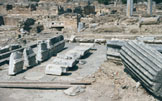 The
large architectural complex which forms the Praetorium covers an area of
about 120x100 meters and was Gortyn's center of government during Roman
times. Although containing public buildings, it was also the location of
the residence of the Roman governor of Crete. The
large architectural complex which forms the Praetorium covers an area of
about 120x100 meters and was Gortyn's center of government during Roman
times. Although containing public buildings, it was also the location of
the residence of the Roman governor of Crete. |
|
 East
of the basilica there were baths built of brick whose relatively small
size indicates that they were probably private baths for the use of the
Proconsul Governor. A colonnade can be seen and also a hall with three
niches. East
of the basilica there were baths built of brick whose relatively small
size indicates that they were probably private baths for the use of the
Proconsul Governor. A colonnade can be seen and also a hall with three
niches. |
|
|
|
|
|
 The
Praetorium is currently being excavated by the Italian Archeological
School. The
Praetorium is currently being excavated by the Italian Archeological
School.
|
|
 The
Praetorium complex underwent several transformations during its lifetime.
The present ruins are mostly of the 4th century CE but structures dating
from the 2nd century CE are visible. The
Praetorium complex underwent several transformations during its lifetime.
The present ruins are mostly of the 4th century CE but structures dating
from the 2nd century CE are visible.
|
|
 The
Temple of Apollo Pythios (Pythion) is one of the most notable and ancient
monuments in Gortyn. The original Archaic temple of the 7th century BCE
was a square building built of poros resembling those found in Cretan
shrines of Minoan origin. The roof was supported by 4 wooden columns of
which only the bases survive. During the Hellenistic period, a vestibule
with six Dorian columns was added. In Roman times, two Corinthian colonnades
were added to the cella and a niche to the west wall for a cult statue of
the god. The large stepped altar with a square trough was also added by
the Romans. The
Temple of Apollo Pythios (Pythion) is one of the most notable and ancient
monuments in Gortyn. The original Archaic temple of the 7th century BCE
was a square building built of poros resembling those found in Cretan
shrines of Minoan origin. The roof was supported by 4 wooden columns of
which only the bases survive. During the Hellenistic period, a vestibule
with six Dorian columns was added. In Roman times, two Corinthian colonnades
were added to the cella and a niche to the west wall for a cult statue of
the god. The large stepped altar with a square trough was also added by
the Romans. |
|
|
|
|
|
 The
remains of an Aqueduct The
remains of an Aqueduct |
|
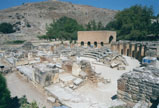 The
Odeon, a small amphitheater where musical recitals were staged, was built
on the site of an older square structure during the 1st century CE. The
small building in the north circular wall of the Odeon (center background) contains the famous
inscriptions of the Gortyn laws. The
Odeon, a small amphitheater where musical recitals were staged, was built
on the site of an older square structure during the 1st century CE. The
small building in the north circular wall of the Odeon (center background) contains the famous
inscriptions of the Gortyn laws.
|
|
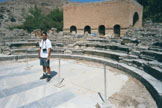 The
cavea of the Odeon has four preserved rows of seats traversed by two
flights of stairs. Behind this run two vaulted passages that would have
supported yet more rows of seats which are not preserved today. The floor
of the orchestra has a black and white marble checkerboard pattern. The
cavea of the Odeon has four preserved rows of seats traversed by two
flights of stairs. Behind this run two vaulted passages that would have
supported yet more rows of seats which are not preserved today. The floor
of the orchestra has a black and white marble checkerboard pattern.
|
|
|
|
|
|
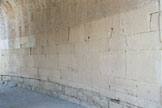 For
the reconstruction of the Odeon, the stones of a nearby archaic circular
building were used, on which were carved the famous Laws of Gortys. Such
codes of law were usually engraved upon the walls of public buildings or
temples and thus often found their way on to the walls of new buildings
when the stones were reused, the original building having been destroyed.
On the northwestern side of the Odeon, four rows of the precious inscribed
stones still survive, constituting the most important record of the Law of
the time. At 10 x 3 meters, this is reputedly the largest Greek
inscription ever found. For
the reconstruction of the Odeon, the stones of a nearby archaic circular
building were used, on which were carved the famous Laws of Gortys. Such
codes of law were usually engraved upon the walls of public buildings or
temples and thus often found their way on to the walls of new buildings
when the stones were reused, the original building having been destroyed.
On the northwestern side of the Odeon, four rows of the precious inscribed
stones still survive, constituting the most important record of the Law of
the time. At 10 x 3 meters, this is reputedly the largest Greek
inscription ever found. |
|
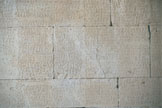 The
inscriptions were carved in a Dorian dialect, in a style known as boustrophedon,
that is, "as the ox plows" (from left to right and then right to
left and so on). They date from the beginning of the 5th century BCE and
are Europe's earliest code. In 600 lines, it details the laws
concerning marriage, divorce, inheritance, adoption, assault and rape, and
the status of slaves. It is a complete code of law, based on Minoan
tradition. It seems that the Cretans has an established
tradition in just government since Minoan times. Aristotle confirms
that the Minoan laws were still valid at this later date for the populations
subject to the Dorians. The
inscriptions were carved in a Dorian dialect, in a style known as boustrophedon,
that is, "as the ox plows" (from left to right and then right to
left and so on). They date from the beginning of the 5th century BCE and
are Europe's earliest code. In 600 lines, it details the laws
concerning marriage, divorce, inheritance, adoption, assault and rape, and
the status of slaves. It is a complete code of law, based on Minoan
tradition. It seems that the Cretans has an established
tradition in just government since Minoan times. Aristotle confirms
that the Minoan laws were still valid at this later date for the populations
subject to the Dorians. |
|
 The
ruins of the early Christian Basilica
of St. Titus consist of three main aisles and a dome of the transitional
type. The east side is the best preserved, together with side walls of the
aisles and the barrel-vaulted roof. The church has many successive
architectural phases but the one seen dates from the 6th century CE. The
ruins of the early Christian Basilica
of St. Titus consist of three main aisles and a dome of the transitional
type. The east side is the best preserved, together with side walls of the
aisles and the barrel-vaulted roof. The church has many successive
architectural phases but the one seen dates from the 6th century CE. |
|
|
|
|
|
 Roman
statue of the Emperor Antoninus Pius Roman
statue of the Emperor Antoninus Pius |
|
 Two
large and finely worked sculptures from the small museum in a loggia that
holds a number of the sculptures found at the site. Two
large and finely worked sculptures from the small museum in a loggia that
holds a number of the sculptures found at the site. |
|
 Another
sculpture in the small museum. Another
sculpture in the small museum. |
|
|
|
|
|
© All pictures are Copyright 2000 Grisel Gonzalez and Jeff
Prosise
|